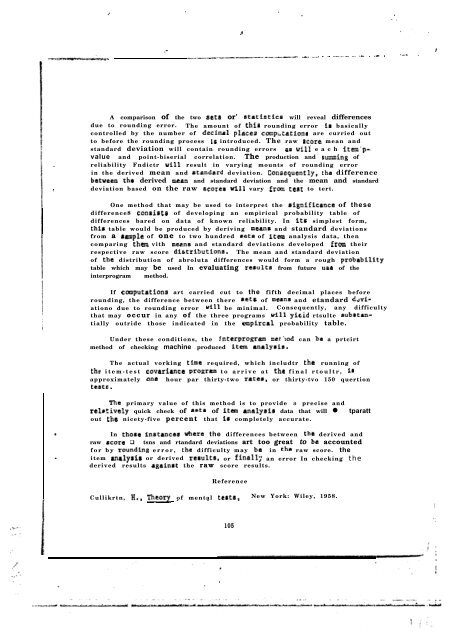Technical Report - International Military Testing Association
Technical Report - International Military Testing Association
Technical Report - International Military Testing Association
Create successful ePaper yourself
Turn your PDF publications into a flip-book with our unique Google optimized e-Paper software.
. .<br />
.- . -<br />
.,<br />
.-<br />
2<br />
:.<br />
-W-.l.W.‘.. --c*--L- I_,__,__,_ __, __L I .- ..-.,_.-. “.. ..-. _ ,*. - .--. -<br />
.<br />
A comparison of the two Set8 or’ statbtics will reveal differences<br />
due to rounding error. The amount of this rounding error 18 basically<br />
controlled by the number of decimal placea compb:atfonr are curried out<br />
to before the rounding process is introduced. The raw acore mean and<br />
standard deviation will contain rounding errors 8~ Viii each itcm’p-.<br />
value and point-biserial correlation. The production and surming of<br />
reliability Fndictr vi11 result in varying mounts of rounding error<br />
in the derived mean and ottndard deviation. Consequently, the difference<br />
batvttn tha derived mean and standard deviation and the mean and standard<br />
* deviation based on the raw 8COitl vi11 vary froai ttlt to tert.<br />
One method that may be used to interpret the tlgniflconce of these<br />
difference8 conaisto of developing an empirical probability table of<br />
differences bared on data of known reliability. In its simplest form,<br />
thlr table would be produced by deriving means and standard deviations<br />
from a rample of one to two hundred eets of item analysis data, then<br />
comparing them vith mt@nS and standard deviations developed fran their<br />
respective raw score di&tributiona. The mean and standard deviation<br />
of the distribution of abroluta differences would form a rough probabi1it.y<br />
table which may be used In evaluating re8ult8 from future u&e of the<br />
interprogram method.<br />
If canputations art carried cut to the fifth decimal places before<br />
rounding, the difference between there #et6 of mtdns and etandard &viationo<br />
due to rounding error vi11 be minimal. Consequently, any difficulty<br />
that may occur in any of the three programs vi11 yicid rtsulte eubstantially<br />
outride those indicated in the rxnplrcal probability table.<br />
Under these conditions, the Jnttrprogram mtt’md can ba a prtcirt<br />
method of checking machine produced item analysis.<br />
The actual vorking time required, which includtr the running of<br />
thb* item-test covariance progrm to arrive at the final rtoultr, 18<br />
approximately one hour par thirty-two ratem, or thirty-tvo 150 quertion<br />
teats.<br />
The primary value of this method is to provide a precise and<br />
relatively quick check of sttm of itan analycllr data that will � tparatt<br />
out the nicety-five percent that is completely accurate.<br />
In thoaa instancea where the differences between the derived and<br />
raw #core � tsns and rtandard deviations art too great to be accounted<br />
for by rounding error, the difficulty may be in the raw score. the<br />
item analyria or derived rteult8, or finally an error In checking the<br />
derived results againrt the raw score results.<br />
Reference<br />
Cullikrtn, Ii., Theory of mental ttatu.<br />
- - -<br />
.<br />
105<br />
New York: Wiley, 1958.<br />
I<br />
..<br />
,









